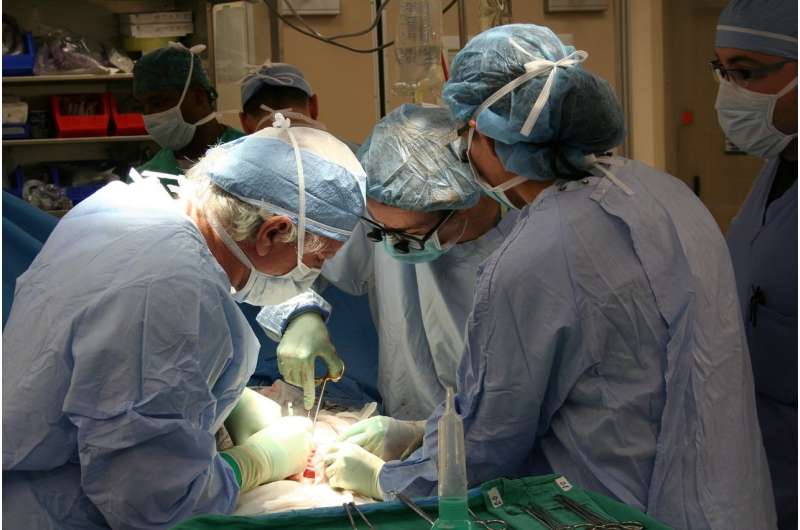Non-Hispanic Black patients are disproportionately left off liver transplant waitlists

A new study of liver transplant centers confirms that non-Hispanic white patients get placed on liver transplant waitlists at disproportionately higher rates than non-Hispanic Black patients. However, researchers went a step further as they identified key reasons for that disparity: disproportionate access to private health insurance, travel distance to transplant centers, and a potential lack of knowledge among both practitioners and patients about available options. The study was selected for the 2020 Southern Surgical Association Program and published as an 'article in press' on the website of the Journal of the American College of Surgeons in advance of print.
"We found that the Black population was underrepresented at the vast majority of centers, meaning that the percentage of the Black population in a donor service area (DSA)—the geographic area the center serves—was significantly higher than the percentage of the Black population on waitlists," said lead author Ali Zarrinpar, MD, Ph.D., FACS, a transplant and hepatobiliary surgeon at the University of Florida, Gainesville.
Dr. Zarrinpar and colleagues analyzed deceased donor liver transplant and waitlist data obtained from the Scientific Registry of Transplant Recipients for 109 high-volume liver transplant centers (250 or more transplant operations over a five-year period from 2013 to 2018), excluding Veterans Affairs centers and Hospital Auxilio Mutuo in San Juan, Puerto Rico, because of its nearly 100 percent Hispanic population. The researchers used five-year U.S. Census Bureau estimates from 2017 to calculate demographics of each center's DSA.
Of 30,353 patients on waitlists at the 109 centers, 69 percent were non-Hispanic white, 7.9 percent were non-Hispanic Black, 17 percent were Hispanic, and 6.1 percent were of other racial or ethnic categories. By comparison, the overall national racial/ethnic distribution from the 2017 Census update was 61.5 percent white, 12.3 percent Black, 17.6 percent Hispanic, and 8.6 percent other racial/ethnic groups.
The disparities shifted a bit when actual liver transplant operations were evaluated: 70.9 percent in whites, 9.4 percent in Blacks, 14 percent in Hispanics, and 5.7 percent in other racial/ethnic groups. Nonetheless, resolving disparities on transplant waitlists would go far toward a more equitable distribution of transplants, the researchers found.
"When we looked at the characteristics of each individual center that correlated with that difference, we found that the more each center transplanted people with private insurance, the less they were representative of the Black population in their donor service area," Dr. Zarrinpar said. "Further, the longer amount of time people traveled to that center for liver transplantation, the less the center was representative of the percentage of the Black population in their donor service area."
Other potential reasons the study evaluated but did not correlate with the disparity include DSA poverty rates, educational levels, the proportion of public and private insurance within the DSA, and whether the center was a public or private institution, Dr. Zarrinpar said.
The findings raise multiple questions about why Black patients are placed on liver transplant waitlists at a much lower rate. "Are underrepresented populations just not getting referred to the transplant centers?" Dr. Zarrinpar asked.
"Another issue is primary care access. Patients need to be made aware earlier on that transplantation is a potential solution for certain liver conditions. If aware, they next need to know what it takes to be placed on a waitlist. Also, we must address the false perception that patients may have that liver transplants aren't covered by insurance, specifically those covered by Medicaid."
In fact, Dr. Zarrinpar added, Medicaid covers liver transplant, and "the vast majority of transplant centers will take public insurance."
Although the study did not look at barriers to liver transplants for underserved populations, they could exist at any number of points along the care spectrum, Dr. Zarrinpar said, including transplant centers, referring centers, referring physicians, or even patients themselves. "The patients may not have insurance at the time they develop their liver disease, but it's possible for the transplant centers to obtain coverage for people who are not just underserved but don't have the means," he said. "Many publicly available insurances exist for these patients."
The authors conclude that increased awareness of these trends may promote equitable access to liver transplant waitlists. Strategies include targeting physicians who could potentially refer these patients, Dr. Zarrinpar said. "As long as a patient has medical need, the ability to undergo a transplant operation successfully, and a support system to ensure long-term success with the transplanted liver, being placed on a transplant waitlist is an option," he said. "We don't want people to rule themselves out before seeking help."
More information: Journal of the American College of Surgeons (2021). doi.org/10.1016/j.jamcollsurg.2020.12.021


















